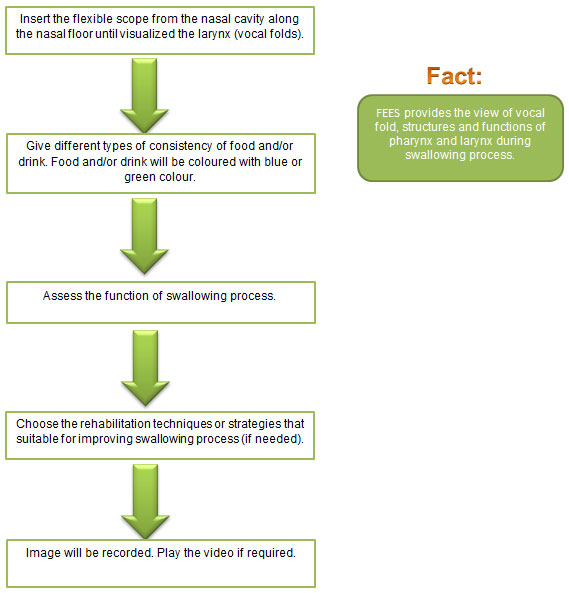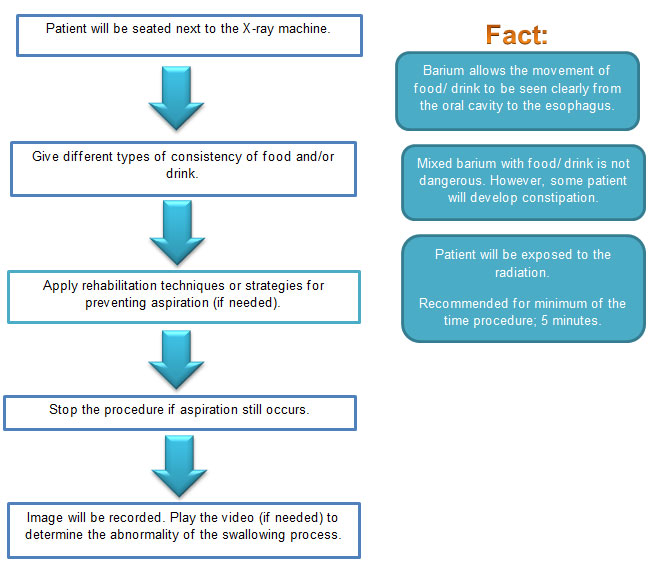Swallowing Instrumental Assessment is one of the comprehensive tests for swallowing. This test used to answer questions that occurred after the clinical assessment had implemented.
What is abnormal swallowing?
Abnormal swallowing or Dysphagia is also known as swallowing disorder. It is maybe due to abnormal structures and functions of oral cavity, pharynx, larynx or esophagus as well as the disturbances in one or more of the swallowing phases.
Abnormal swallowing will bring short term effects such as cough and/or throat clearing during eating or drinking. Other than that, there are long term effects such as aspiration and pneumonia (lung inflammation).
Abnormal swallowing can be identified as:
- No swallowing reflex during eating or drinking.
- Abnormal swallow-breath pattern. Patient is breathing during swallowing. It will cause coughing and high risk of aspiration.
Click here to view ? MBSImP Sample Animation: penetration &Aspiration by NorthenSpeech
What types of Swallowing Instrumental Assessment?
These are the types of Swallowing Instrumental Assessment that commonly used by Speech Therapist:
- Fiberoptic Endoscopic Evaluation of Swallowing (FEES)
- Videofluoroscopic Swallowing Study (VFSS)/ Modified Barium Swallow (MBS)/ “Cookie swallow”
- FEES combined with Sensory Testing (FEEST)
- Electromyography (EMG)
What are the indications for Swallowing Instrumental Assessment?
Swallowing instrumental assessment is used for assessment and treatment to high risk population of swallowing disorder.
- Swallowing instrumental assessment requires for those who have these criteria:
- Symptoms of swallowing disorder that inconsistent with clinical assessment’s result.
- Confirmation of the swallowing diagnosis.
- Answer questions that relate to nutritional problem or lung problem due to swallowing disorder.
- When the swallowing process safety been focused.
- Patient is suitable for swallowing rehabilitation.
- Swallowing instrumental assessment not requires when the patient fails the clinical assessment or has shown one or more criteria below:
- Not stable in any medical health problem. So, patient unable to give commitment to the procedure.
- Unable to give co-operation for the swallowing instrumental assessment.
- Based on Speech Therapist judgement, swallowing instrumental assessment’s result will not change any rehabilitation strategies or techniques.
Guideline –> Clinical Indicators for Instrumental Assessment of Dysphagia
There are two types of swallowing instrumental assessment that will be discussed; which are Fiberoptic Endoscopic Evaluation of Swallowing (FEES) and Videofluoroscopic Swallowing Study (VFSS).
What is Fiberoptic Endoscopic Evaluation of Swallowing (FEES)?
Fiberoptic Endoscopic Evaluation of Swallowing (FEES) is one of the procedures that assess swallowing functions related to oro-pharynx and larynx structures.
FEES also used for determination of rehabilitation techniques or strategies as an intervention plan for the patient.
This procedure needs collaboration between Speech Therapist and ENT Medical Officer/ Specialist.
What is Videofluoroscopic Swallowing Study (VFSS)?
Videofluoroscopic Swallowing Study (VFSS) is a radiological procedure for swallowing assessment.
The procedure needs collaboration between Speech Therapist and Radiologist.
VFSS requires for :
- Determine aspiration .
- Determine the malfunction of oral cavity structures.
- Types of food that safe for oral feeding.
- Rehabilitation techniques or strategies for improving swallowing process.
How Fiberoptic Endoscopic Evaluation of Swallowing (FEES) been implemented?
Procedures of Fiberoptic Endoscopic Evaluation of Swallowing (FEES) :
Video normal FEES (Fiberoptic Endoscopic Evaluaation of Swallowing (FEES) by Mobile Endoscopix)
Video abnormal FEES (Aspiration after the swallow by GI Motility)
How Videofluoroscopic Swallowing Study (VFSS) been implemented?
Procedure Videofluoroscopic Swallowing Study (VFSS):
Normal VFSS (My X Ray Swallows by spladgum)
Abnormal VFSS (Aspiration by alanswatches)
See Speech Therapist if you or your family members show symptoms of dysphagia/ swallowing disorder!!!!
| Last Reviewed | : | 28 August 2020 |
| Writer / Translator | : | Nurul Haslina bt. Mohd Zin |
| Accreditor | : | Marina bt. Abdul Malek |
| Reviewer | : | Nadwah bt. Onwi |









